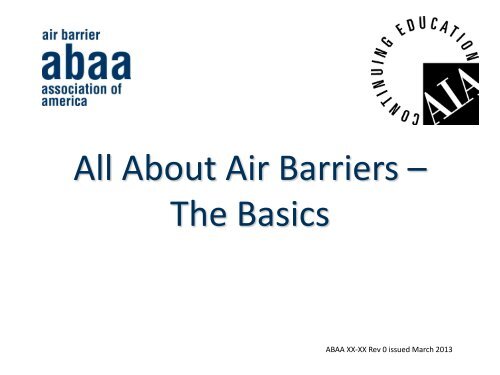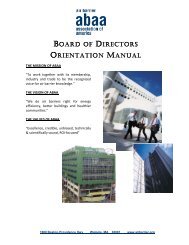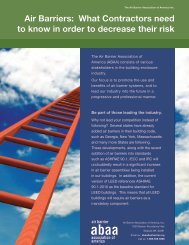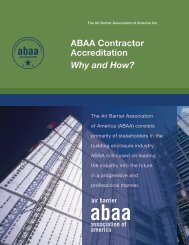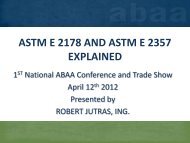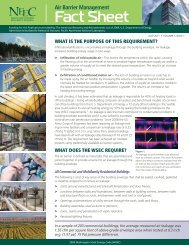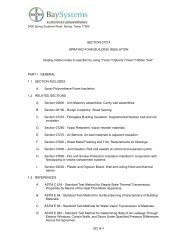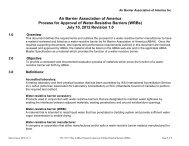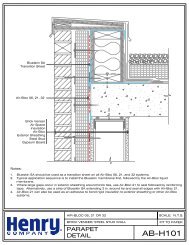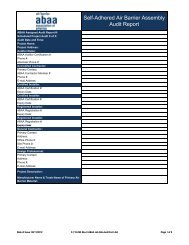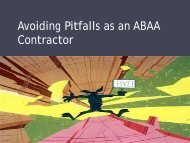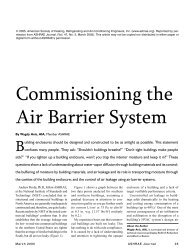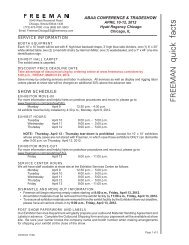Laverne Dalgleish - Basic Air Barrier Requirements
Laverne Dalgleish - Basic Air Barrier Requirements
Laverne Dalgleish - Basic Air Barrier Requirements
Create successful ePaper yourself
Turn your PDF publications into a flip-book with our unique Google optimized e-Paper software.
All About <strong>Air</strong> <strong>Barrier</strong>s –<br />
The <strong>Basic</strong>s<br />
ABAA XX-XX Rev 0 issued March 2013
ABAA Process for Approval<br />
– Explained<br />
<strong>Air</strong> <strong>Barrier</strong> Association of America (ABAA) is a Registered Provider with<br />
the American Institute of Architects Continuing Education Systems.<br />
Credit earned on completion of this program will be reported to CES<br />
Records for AIA members. Certificates of Completion for non-AIA<br />
members are available on request.<br />
This program is registered with the AIA/CES for continuing professional<br />
education. As such, it does not include content that may be deemed or<br />
construed to be an approval or endorsement by the AIA of any material<br />
of construction or any method or manner of handling, using,<br />
distributing, or dealing in any material or product. Questions<br />
related to specific materials, methods, and services will be<br />
addressed at the conclusion of this presentation.
Copyright Materials<br />
This presentation is protected by US and International Copyright laws.<br />
Reproduction, distribution, display and use of the presentation<br />
without written permission of the speaker is prohibited.<br />
© <strong>Air</strong> <strong>Barrier</strong> Association 2013
<strong>Air</strong> <strong>Barrier</strong> Association of America<br />
PRESENTATION CODE OF ETHICS-<br />
The Representative, when speaking about <strong>Air</strong> <strong>Barrier</strong> technology and using language,<br />
information, presentations, logos, or any other communication means that could be<br />
reasonably likely to cause the recipient(s) of such information to believe that the<br />
communication represents an official ABAA technical viewpoint, shall:<br />
• Hold themselves out to the public with professionalism and sound ethics by conducting<br />
themselves in a way which reflects positively on ABAA and the ABAA members<br />
• Clearly state their affiliation<br />
• Identify their relationship with ABAA<br />
• Declare that they are presenting an official (unmodified) presentation prepared by ABAA<br />
• Indicate whether the presentation is at the official request of ABAA<br />
• This is an AIA Accredited Presentation<br />
• This presentation will not highlight focus or reference to a specific product of<br />
manufacturer
Learning Objectives<br />
• Explain “air barrier” terminology<br />
• Understanding building science principles<br />
• Explain air barrier basics<br />
• List air barrier codes and standards<br />
requirements
• air barrier material<br />
Definitions<br />
building material with an air permeance not greater than 0.02<br />
L/s·m² at 75 Pa that is designed and constructed to provide<br />
the primary resistance to airflow through an air barrier<br />
assembly.<br />
• Vapor Permeable (vapor <strong>Barrier</strong>)<br />
The property of having a moisture vapor permeance rating of<br />
10 perms (5.7x 10 -10 kg/Pa◦s◦m 2 ) - IBC [5 perms (2.9x 10 -10<br />
kg/Pa◦s◦m 2 ) – IRC] or greater, when tested in accordance<br />
with the desiccant method using Procedure A of ASTM E96.
• air barrier accessory<br />
Definitions<br />
materials designated to maintain air tightness between air<br />
barrier materials, air barrier assemblies and air barrier<br />
components, to fasten them to the structure of the building,<br />
or both.<br />
• air barrier assembly<br />
combination of air barrier materials and air barrier<br />
accessories that are designated and designed within the<br />
environmental separator to act as a continuous barrier to the<br />
movement of air with an air leakage not greater than 0.20<br />
L/s·m² at 75 Pa.
• air barrier system<br />
Definitions<br />
combination of air barrier assemblies and air barrier<br />
components, connected by air barrier accessories, that are<br />
designed to provide a continuous barrier to the movement of<br />
air through an environmental separator .<br />
• air barrier components<br />
pre-manufactured elements such as windows, doors and<br />
service elements.
Definitions<br />
• Water vapor permeability<br />
time rate of water vapor transmission through a material at a<br />
specific thickness. This would be most applicable to materials<br />
that can vary in thickness such as boardstock, fluid-applied, spray<br />
polyurethane foam (SPF) air barriers.<br />
• Water vapor permeance<br />
the time rate of water vapor transmission through a material of a<br />
unit thickness. Permeance is a performance evaluation and not<br />
a property of a material. This would be most applicable to<br />
materials which don’t vary in thickness such as self-adhered<br />
sheet materials and mechanically fastened building wraps.
Six <strong>Air</strong> <strong>Barrier</strong> Materials<br />
• Mechanically Fastened - Membranes<br />
• Mechanically Fastened - Insulating Boardstock<br />
• Mechanically Fastened - Non-insulating<br />
Boardstock<br />
• Self-adhered Membrane<br />
• Fluid-applied Foaming<br />
• Fluid-applied Non-foaming
Building Science<br />
The definition of building science is the<br />
“<br />
physics of:<br />
• Heat flow<br />
• <strong>Air</strong> flow<br />
• Moisture flow – in a building
Building Science<br />
The building is a system.<br />
A building is made up of many components<br />
that work together:<br />
• Building enclosure<br />
• People<br />
• Mechanical system<br />
• Ambient conditions
Building Science<br />
The building enclosure is:<br />
• The building components that separate<br />
one environment from another<br />
environment.<br />
• Includes inside environment from<br />
outside environment<br />
• Can also include one environment from<br />
another environment within a building
Building Science<br />
People effect buildings by:<br />
• Daily activities (bathing, breathing,<br />
cooking, etc.)<br />
• How they treat the building envelope<br />
(opening window, etc.)<br />
• How they operate the mechanical<br />
system (positive or negative<br />
pressurization)
Building Science<br />
Mechanical systems effect buildings by:<br />
• Adding / removing heat<br />
• Adding / removing moisture<br />
• Creating different air pressures<br />
• Moves air / heat / moisture from one part of<br />
the building / building component of another
Building Science<br />
Ambient conditions effect buildings by:<br />
• <strong>Air</strong> leakage containing water vapor<br />
• Bulk water leaking into walls through:<br />
• voids in WRB<br />
• improper drainage in design/installation<br />
• Creating different air pressures<br />
• Drying potential of climate<br />
• Freeze/thaw
Building Science<br />
Effects of uncontrolled air leakage…
Building Science<br />
Heat always flows from hot to cold<br />
Heat Flow:<br />
• Requires temperature difference<br />
• Rate is dependant on temperature<br />
difference<br />
• Greater temperature difference equals<br />
greater heat flow
Building Science<br />
What are the three ways heat flow?<br />
• Conduction<br />
• Convection<br />
• Radiation
Building Science<br />
Conduction:<br />
• Heat transferring through<br />
a substance<br />
• Rate is based on<br />
temperature difference<br />
• Different materials have<br />
different flow rates<br />
What are examples of heat flow by<br />
conduction?
Building Science<br />
Convection:<br />
• Heat transferred from one surface<br />
to another surface by means of a<br />
fluid medium (ie. air, water, etc.)<br />
• Rate is based on temperature<br />
difference and type of medium<br />
What are examples of heat flow<br />
by convection?
Building Science<br />
Radiation<br />
• Heat transferring from the<br />
source to an object without<br />
heating the medium<br />
between<br />
• Rate based on strength of<br />
heat source and ability of<br />
object to absorb energy<br />
What are examples of heat flow by<br />
radiation?
Building Science<br />
Pressure differences are caused by:<br />
• Stack effect<br />
• Wind effect<br />
• Flue and ventilation effect
Building Science<br />
Stack Effect<br />
• In winter warm air rises and causes:<br />
• Exfiltration (positive pressure) at top<br />
• Infiltration (negative pressure) at bottom<br />
• In summer the air pressures are opposite:<br />
• Exfiltration (negative pressure) at top<br />
• Infiltration (positive pressure) at bottom
STACK EFFECT<br />
Building Science
Building Science<br />
Wind Effect<br />
• Wind blows against the building and<br />
causes:<br />
• High pressure on the windward side<br />
• Low pressure on leeward side<br />
• Infiltration on windward side<br />
• Exfiltration on leeward side<br />
• Low pressure forces can be higher than higher<br />
pressures
WIND PRESSURE<br />
+ PRESSURE<br />
Building Science<br />
- PRESSURE
Building Science<br />
Mechanical pressurization and ventilation<br />
effect:<br />
• Fans draw air through a building<br />
• Will create negative and positive pressures in<br />
a building<br />
• Causes infiltration and exfiltration through a<br />
building
MECHANICAL<br />
PRESSURIZATION<br />
Building Science
MECHANICAL<br />
PRESSURIZATION<br />
Building Science
Building Science<br />
Moisture (water):<br />
• Can exist as a solid or liquid<br />
• Moves from wet to dry<br />
• Moves to the path of least resistance
Building Science<br />
Water moisture flows four different ways:<br />
• Gravity<br />
• Capillary<br />
• Diffusion<br />
• <strong>Air</strong> transport
Gravity<br />
Building Science<br />
Use shingles, flashings, etc. to protect buildings<br />
It has been estimated that bulk Water causes 90% of the<br />
problems in buildings.
Capillary<br />
Building Science<br />
Use a capillary break or moisture barrier to protect building
Building Science<br />
Diffusion - through a material<br />
Use a vapor barrier / vapor retarder to protect building
<strong>Air</strong> Transport<br />
Building Science<br />
Use an <strong>Air</strong> <strong>Barrier</strong> or do air sealing to protect the building
Building Science<br />
1 METRE<br />
1 METRE<br />
TRANSPORT VIA AIR LEAKAGE<br />
30 LITRES<br />
2 cm x 2 cm HOLE<br />
TRANSPORT VIA DIFFUSION<br />
0.5 LITRES<br />
*ASSUMES RH 40%, 2 COATS ENAMEL PAINT, OTTAWA CLIMATE
Building Science<br />
Water vapor condensing in the building<br />
envelope leads to problems<br />
such as:<br />
• Mold<br />
• Corrosion<br />
• Wood rot<br />
• Ice lensing, etc.
Building Science<br />
Relative Humidity<br />
• The amount of moisture in the air compared<br />
to the amount of moisture the air can hold at<br />
a specific temperature. This will change as<br />
temperature changes even when the absolute<br />
humidity remains exactly the same.
Building Science<br />
Dew Point<br />
• The temperature where the relative<br />
humidity reaches 100% and the water vapor<br />
changes to liquid water<br />
• Remember liquid water causes 90% of the<br />
problems in buildings
Building Science<br />
Conclusion<br />
• Need to look at buildings as a system<br />
• <strong>Air</strong> barriers are only one component, we<br />
need to look at insulation, drainage,<br />
permeability, ambient conditions, etc<br />
• You need to address mechanical systems<br />
with building air-tightness<br />
• Building enclosures are important link to<br />
building performance and energy efficiency
Introduction to <strong>Air</strong> <strong>Barrier</strong>s<br />
What materials does ASHRAE 90.1 classify as<br />
air barrier materials?<br />
• Plywood-minimum 3/8 in.<br />
• Oriented strand board-minimum 3/8 in.<br />
• Extruded polystyrene insulation board-minimum ½ in<br />
• Foil-faced urethane insulation board-minimum ½ in<br />
• Exterior gypsum sheathing or interior gypsum boardminimum<br />
1/2 in.<br />
• Cement board-minimum 1/2 in.<br />
• Built up roofing membrane<br />
• Modified bituminous roof membrane
Introduction to <strong>Air</strong> <strong>Barrier</strong>s<br />
What materials does ASHRAE 90.1 classify as<br />
air barrier materials?<br />
• Fully adhered single-ply roof membrane<br />
• A Portland cement/sand parge, stucco, or gypsum plasterminimum<br />
1/2 in. thick<br />
• Cast-in-place and precast concrete.<br />
• Sheet metal<br />
• Closed cell 2 lb/ft 3 nominal density spray polyurethane foamminimum<br />
1 in.
Introduction to <strong>Air</strong> <strong>Barrier</strong>s<br />
What materials are NOT classified as air<br />
barrier materials?<br />
• Tempered hardboard, plain fiberboard, flakewood board<br />
• Asphalt saturated felt paper (15# and 30#)<br />
• Vermiculite insulation<br />
• Concrete Masonry Units<br />
• Expanded Polystyrene<br />
• Glass fiber rigid insulation board<br />
• Asphalt-impregnated fiberboard<br />
• Glasswool & Cellulose Insulation<br />
• Brick
Introduction to <strong>Air</strong> <strong>Barrier</strong>s<br />
<strong>Air</strong> barrier materials can be:<br />
• Vapor Permeable (high perm rating)<br />
• Non-Vapor Permeable (low perm rating -<br />
provides vapor barrier function)<br />
• Insulation (providing air, vapor and thermal<br />
function)
Introduction to <strong>Air</strong> <strong>Barrier</strong>s<br />
<strong>Air</strong> barrier assembly key requirements<br />
• Continuity (most important / most difficult)<br />
• Strength<br />
• Durability<br />
• (Im)Permeability
Introduction to <strong>Air</strong> <strong>Barrier</strong>s<br />
<strong>Air</strong> barrier system requirements<br />
• The air barrier system shall be joined in an air-tight and<br />
flexible manner allowing for the relative movement of<br />
elements due to structural and hygrothermal<br />
expansion/contraction.<br />
• Connections using transitions shall be made between:<br />
• foundation and walls<br />
• walls and windows or doors (different wall systems)<br />
• penetrations<br />
• roof and wall<br />
• change in plane<br />
• change in substrate
Introduction to <strong>Air</strong> <strong>Barrier</strong>s<br />
More than just air permeance?<br />
• ABAA has developed listed of other physical properties and<br />
performance requirements for a variety of commercially<br />
available air barrier materials. This is based on four key<br />
requirements which attempt to duplicate loads on the<br />
building:<br />
• <strong>Air</strong> leakage<br />
• Continuity<br />
• Strength<br />
• Durability
Liquid Applied Membranes
Self-Adhered Sheet <strong>Air</strong> <strong>Barrier</strong>s
Medium Density S.P.F.
Mechanically Fastened Building Wraps
Boardstock <strong>Air</strong> <strong>Barrier</strong>
Code <strong>Requirements</strong><br />
• ASHRAE 90.1-2010<br />
• ASHRAE 189.1-2011<br />
• 2012 IECC (International Energy Conservation<br />
Code)<br />
• 2012 IRC (International Residential Code)<br />
• 2012 IgCC (International Green Construction<br />
Code)<br />
• 2012 IBC (International Building Code)<br />
• State code changes
ASHRAE 90.1-2010<br />
Code <strong>Requirements</strong>
Code <strong>Requirements</strong><br />
ASHRAE 189.1-2011
Code <strong>Requirements</strong><br />
2012 IECC – Commercial Buildings
Code <strong>Requirements</strong><br />
2012 IECC – Residential Houses
2012 IRC<br />
Code <strong>Requirements</strong>
2012 IgCC<br />
Code <strong>Requirements</strong>
Code <strong>Requirements</strong><br />
2012 IBC<br />
• There are no air barrier requirements in the<br />
2012 International Building Code.
Code <strong>Requirements</strong>
Code <strong>Requirements</strong><br />
Check the ABAA website for up to date<br />
information regarding code and standards<br />
status, and further links regarding code<br />
information in various states.
It is proposed that LEED v4 will reference ASHRAE 90.1-2010<br />
as the baseline standard for energy efficiency in LEED<br />
buildings.<br />
What does this mean?<br />
LEED <strong>Requirements</strong><br />
LEED buildings will require air barriers as a<br />
mandatory component.
States that currently require air barriers by<br />
code:<br />
• Illinois<br />
• Massachusetts<br />
• Minnesota<br />
• Georgia<br />
• Rhode Island<br />
• New York<br />
• Maryland<br />
Code <strong>Requirements</strong>
Code <strong>Requirements</strong> – Whole<br />
Building <strong>Air</strong> Leakage Testing<br />
Washington State: buildings over five stories<br />
require a whole building test but the code<br />
does not require the building to pass a<br />
prescribed value.<br />
City of Seattle : All Buildings require a whole<br />
building test conducted but the code<br />
requirement does not require the building to<br />
pass a prescribed value.
• Peanut butter<br />
<strong>Air</strong> <strong>Barrier</strong> Material???<br />
– Smooth peanut butter<br />
– Applied at 20 mils wet<br />
– Tested to ASTM E2178<br />
– <strong>Air</strong> leakage result -<br />
0.0021 L/s·m 2<br />
– Is an air barrier material but cannot be installed as<br />
a continuous one and will not stand up to servicelife<br />
conditions.
Learning Objectives<br />
• Explain “air barrier” terminology<br />
• Understanding building science principles<br />
• Explain air barrier basics<br />
• List US air barrier codes and standards<br />
requirements
Thank you for your time!<br />
QUESTIONS??<br />
This concludes The American Institute of Architects Continuing<br />
Education Systems Program<br />
1600 Boston-Providence Hwy<br />
Walpole, MA 02081 USA<br />
www.airbarrier.org
Contact<br />
<strong>Laverne</strong> <strong>Dalgleish</strong><br />
ABAA – Executive Director<br />
ldalgleish@airbarrier.org<br />
1-866-956-5888


